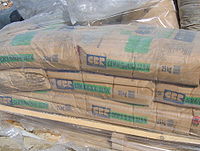
Photo from wikipedia
Abstract Three clinkers and a blast furnace slag, ground separately, were combined to produce 27 cements. Each cement consisted of 35% fine (∼6000 cm 2 /g), 25% intermediate (∼4000 cm 2 /g),… Click to show full abstract
Abstract Three clinkers and a blast furnace slag, ground separately, were combined to produce 27 cements. Each cement consisted of 35% fine (∼6000 cm 2 /g), 25% intermediate (∼4000 cm 2 /g), and 40% coarse (∼2500 cm 2 /g) particles. Slag made up the fine or intermediate particles in the blended cements, clinkers making up the remainder. Compressive strength was measured up to 28 d on mortars and heat evolution was investigated up to 48 h using isothermal calorimetry. Portland cements with different rates of strength gain and heat evolution could be obtained by mixing different clinkers. By combining clinkers, cements with lower early heat but higher strength could be prepared. The fine particles in the cements are responsible for strength gain up to 3 d, but the intermediate fraction is crucial for 28-d strength. Slag increasingly contributes to hydration after the 3–7 d period. Fine slag particles decrease early strength but allow high later-age strengths while intermediate slag particles allow smaller drops in early strength but yield lower 28-d strengths. Similarly, replacement of fine clinker particles with slag decreases 12-h heat more than replacement of intermediate particles but the difference diminishes beyond about 24 h. A strong linear relation exists between the 24-h and 48-h heats of the cements and could be useful for modelling the hydration rate of Portland or blended cements. Moderate relations exist between 12–48-h heat, and 1–7-d strength. A strong linear relation is observed between strength and heat measurements made at the same age. Strengths of the cement mortars are mostly within 20% of that estimated by the developed relation.
Journal Title: Construction and Building Materials
Year Published: 2017
Link to full text (if available)
Share on Social Media: Sign Up to like & get
recommendations!